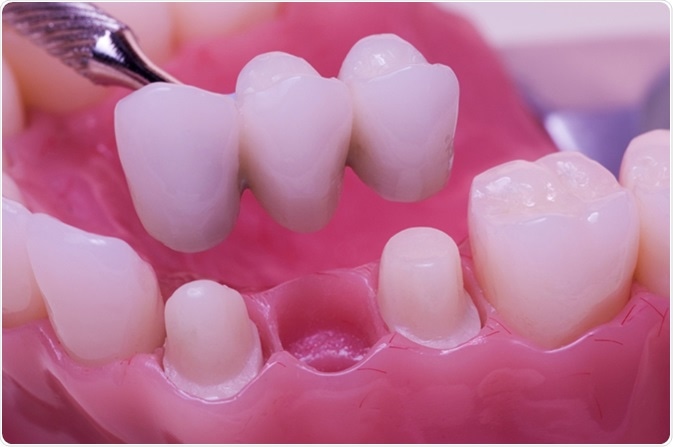There are three main types of dental bridges: traditional fixed bridges, cantilever bridges and Maryland bonded bridges. Each of these is described in more detail below, as well as a section to uncover the differences between them and the indications for the use of each type of dental bridge.
Traditional Fixed Bridges
Traditional fixed bridges create a filler tooth that is supported by crowns placed over healthy teeth on either side of the gap in the mouth to keep the bridge in place. This is the most common type of bridge, and it is typically made from porcelain fused to metal or ceramics.
This type of bridge is used to replace missing teeth where there are healthy teeth on either side of the gap that are able to support a bridge between them. Both of these teeth will need to be reshaped and fitted with crowns before the bridge can be placed, to ensure they are strong enough to support the bridge.

Bonded Fixed-fixed Bridge Preparation. Image Credit: RCB Shooter / Shutterstock
Cantilever Bridges
Cantilever bridges can be utilized when there are no teeth on one side of the missing tooth where the pontic can be fixed, so only one side supports the bridge with a healthy tooth and crown.
This is also indicated for certain clinical situations when there are no teeth on both sides of the missing teeth. Again, a situation may occur when it is not desirable to prepare teeth on both sides for a crown for aesthetic reasons, for example, if a front tooth is on one side of the missing tooth. It is also used if it is the back tooth that is missing. Additionally, if the abutment is already supporting another prosthetic restoration it may not be able to support a traditional fixed bridge.
Cantilever bridges are designed for the pontic to be located outside of the abutment teeth. They involved increased, off-the-axis forces to act on the abutment tooth and support the pontic. As a result, their placement must be carefully planned out to reduce the risk of destabilizing the abutment teeth.
Cantilever Tooth Bridge - Roseville Dentist
Maryland Bonded Bridges
Maryland bonded bridges, also known as resin-bonded bridges, are commonly used to replace front teeth.
They are made from a metal framework with porcelain fused to metal teeth.
The pontic is fixed to the adjacent healthy teeth with metal or porcelain wings on either side of the bridge, which are fixed behind the adjacent teeth.
The Maryland bridge is a more conservative alternative than the traditional fixed bridge because it does not require reshaping and the placement of crowns on the adjacent teeth. Instead, the metal wings fit behind the abutment teeth.
Dentist - Maryland Bridge Procedure
Uses of Different Types of Dental Bridges
Each type of dental bridge is intended for a specific purpose. They are all used to replace a missing tooth but each has certain characteristics that make it preferable for particular situations.
The traditional fixed bridge is preferred in most situations because it offers the most strength for the bridge, from abutment teeth on either side of the pontic. However, if there is no place to fix the bridge on one side of the gap, a cantilever bridge may need to be used. This uses off-the-axis forces on the abutment tooth to support the pontic on only one side. Finally, a Maryland bonded bridge may be the best option for abutment teeth that are highly visible, such as those at the front of the mouth. With this type of bridge, there is no need to reshape the tooth and fix a crown because the pontic can adhere to the back of the abutment teeth.
References
- https://my.clevelandclinic.org/health/articles/dental-bridges
- https://www.bsrd.org.uk/
- http://www.infodentis.com/dental-bridge/features.php
- http://www.infodentis.com/dental-bridge/cantilever-bridge.php
- https://www.slideshare.net/Yumzz/types-of-crown-bridges
Further Reading
Last Updated: Dec 29, 2022